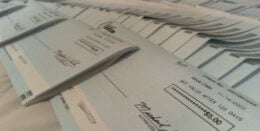
It didn’t come as a surprise to any of us at LRWC that the post about not using credit cards generated so much conversation and that so many readers have strong, staunch opinions about their cards (or lack thereof).
How to Use Credit Cards – The Right Way!
Clearly, getting rid of the plastic is only one side of the argument, and while we can all agree that carrying balances on a credit card is never a good idea, there are many people (myself included) who whole-heartedly embrace using credit cards the RIGHT way. When exploring responsible credit card usage, it’s essential to consider Nav credit cards, which offer tailored solutions for businesses seeking financial flexibility and strategic financial management.
Credit Card Rewards and Cash Back Incentives
The number one reason commenters on last week’s post stated for using their credit cards was their rewards systems and cash back opportunities. As one reader pointed out, “it’s like getting free money.” And she’s absolutely right. As long as you pay your balances, in full, each month, many credit cards offer users amazing rewards and money-making opportunities that can maximize couponing and catalina rewards. But you need to have the “right” cards. One of my personal favorites, the Chase Freedom card, offers 5% cash back on select purchases every quarter. As another reader pointed out, this quarter that includes grocery stores, which is akin to taking 5% off my total grocery purchases for the month. Similar cards, such as the Target RED card, offer users the same advantages, but only at their establishments.
Other rewards include airline miles, physical items, and gift certificates. Paying attention to the “real” value of these options is another way users can maximize their card use and make money. In general, a cash back total translates to 10 points = $1 statement credit or physical check. However, gift certificates may be priced more favorably. I have gotten a $25 gift certificate for 200 points, for example. This adds up to even more free items as you maximize your point usage.
Bottom Line: To use your credit cards the right way, you need to comparison shop before you get them, before you charge with them, and before you cash out your rewards earnings.
Credit Cards and Budgeting
The second most referenced benefit to credit card use is the way that, properly used, credit cards actually aid in budgeting and overall financial health. One way that this works for my family – and many others like us – is that we designate specific cards for specific purchases. Using the rewards maximization principle I outline above, we choose a specific card for that month’s groceries, gas, restaurants, and special purchases (say, a trip to the outlet mall). This way, at the end of the month, I have a clear breakdown of what we spent and where and can easily enter it into my ledgers.
People who don’t carry multiple cards can do the same by entering each charge separately. Some credit card bills, such as Discover, even include purchase category breakdowns for you, especially if they use those categories to determine cash back totals. While you could easily do the same thing with cash receipts (or a debit card statement), the convenience this offers in addition to rewards is just another way that credit cards can and do make life easier.
Bottom Line: Credit card bills offer a simple, condensed picture of an individual or family’s monthly budget that saves time over cash receipts.
Knowledge Is Power
When it comes to responsible use of credit cards, and deriving real value from them, there is much more to the process than simply paying off your bill every month. Using credit cards the right way is a mental exercise of sorts that asks you to consider, track, and understand a lot of particulars about your cards and your spending. Ignoring these factors, even for a little while, is what gets a lot of people into trouble with their cards.
Knowing details like interest rates, closing dates, and fees for each and every card you own is essential. This way, in the event that you do need to pay less than the total balance, you can do so with the least possible damage (i.e. by incurring the least amount of interest).
You should also have a running total of your balance in your head at all times – or at least a rounded figure close to it. Not only does this keep your budgeting on track, but like cash envelopes, it allows you to stop making purchases when you know you’ve exceeded your self-imposed limit. This degree of self-control is absolutely crucial for anyone who uses credit cards as part of a budget.
Bottom Line: When used in the right way, credit cards offer you a ton of real benefits including money-making opportunities. However, this is only possible if you have the wherewithal and self-control to monitor your credit card spending, track the details of your cards, and control your purchases with “invisible” money.



